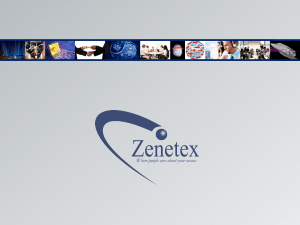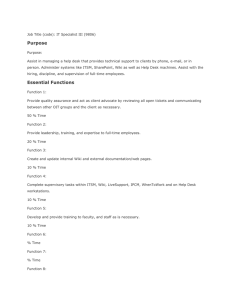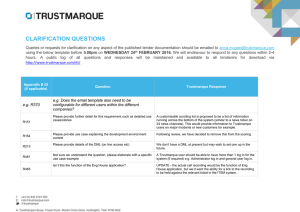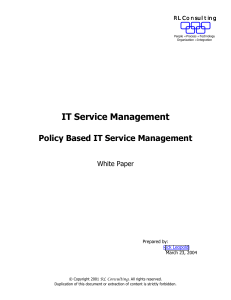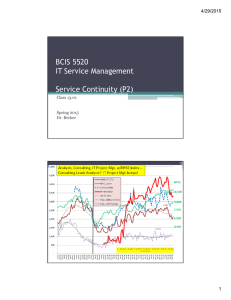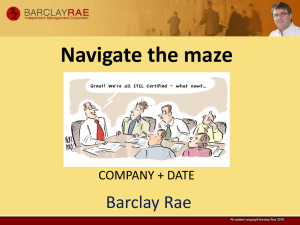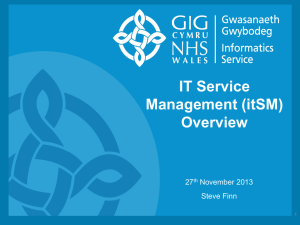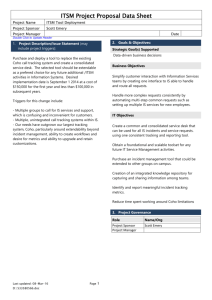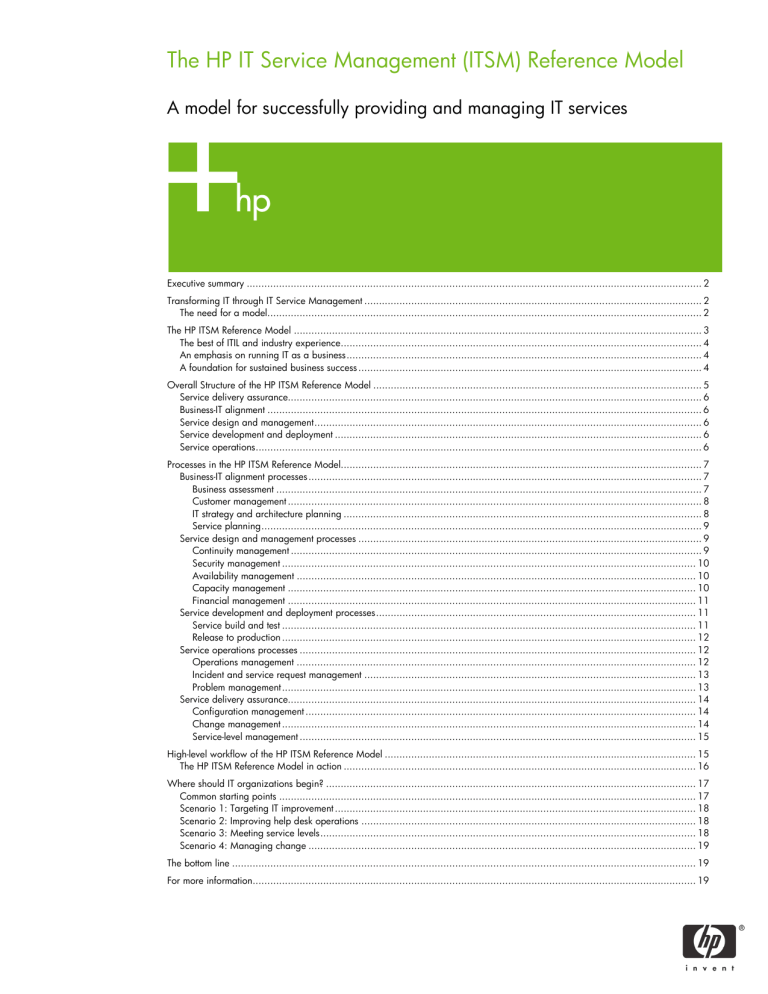
The HP IT Service Management (ITSM) Reference Model A model for successfully providing and managing IT services Executive summary ........................................................................................................................................................... 2 Transforming IT through IT Service Management ................................................................................................................... 2 The need for a model.................................................................................................................................................... 2 The HP ITSM Reference Model ........................................................................................................................................... 3 The best of ITIL and industry experience........................................................................................................................... 4 An emphasis on running IT as a business......................................................................................................................... 4 A foundation for sustained business success ..................................................................................................................... 4 Overall Structure of the HP ITSM Reference Model ................................................................................................................ 5 Service delivery assurance............................................................................................................................................. 6 Business-IT alignment .................................................................................................................................................... 6 Service design and management.................................................................................................................................... 6 Service development and deployment ............................................................................................................................. 6 Service operations........................................................................................................................................................ 6 Processes in the HP ITSM Reference Model........................................................................................................................... 7 Business-IT alignment processes ...................................................................................................................................... 7 Business assessment ................................................................................................................................................. 7 Customer management ............................................................................................................................................. 8 IT strategy and architecture planning .......................................................................................................................... 8 Service planning...................................................................................................................................................... 9 Service design and management processes ..................................................................................................................... 9 Continuity management ............................................................................................................................................ 9 Security management ............................................................................................................................................. 10 Availability management ........................................................................................................................................ 10 Capacity management ........................................................................................................................................... 10 Financial management ........................................................................................................................................... 11 Service development and deployment processes............................................................................................................. 11 Service build and test ............................................................................................................................................. 11 Release to production ............................................................................................................................................. 12 Service operations processes ....................................................................................................................................... 12 Operations management ........................................................................................................................................ 12 Incident and service request management ................................................................................................................. 13 Problem management............................................................................................................................................. 13 Service delivery assurance........................................................................................................................................... 14 Configuration management ..................................................................................................................................... 14 Change management ............................................................................................................................................. 14 Service-level management ....................................................................................................................................... 15 High-level workflow of the HP ITSM Reference Model .......................................................................................................... 15 The HP ITSM Reference Model in action ........................................................................................................................ 16 Where should IT organizations begin? .............................................................................................................................. 17 Common starting points .............................................................................................................................................. 17 Scenario 1: Targeting IT improvement ........................................................................................................................... 18 Scenario 2: Improving help desk operations .................................................................................................................. 18 Scenario 3: Meeting service levels................................................................................................................................ 18 Scenario 4: Managing change .................................................................................................................................... 19 The bottom line .............................................................................................................................................................. 19 For more information....................................................................................................................................................... 19 1 Executive summary Given that effective, reliable, flexible IT services are critical to the success of business initiatives today, enterprises are increasingly seeking to transform IT from a traditional technology provider to a reliable, low-cost IT service provider. This level of IT transformation can be realized today, but it requires significant changes that have inherent risks. How can enterprises safely transform their IT organizations? Where do they start? Many IT organizations are turning to IT Service Management (ITSM)—and the industry-unique HP ITSM Reference Model—for answers. ITSM focuses on delivering and supporting IT services that are appropriate to the business requirements of the organization, and it achieves this by leveraging IT Infrastructure Library (ITIL)-based best practices that promote business effectiveness and efficiency. Attempting to apply ITIL guidelines can be daunting, because they demand far-reaching changes that affect people, processes, and technology. To help its customers move forward with greater ease and confidence, HP assembled a team of IT service (ITS) experts worldwide to develop an HP ITSM Reference Model that can be used as a tool for corporate IT organizations. The HP ITSM Reference Model functions as a high-level, fully integrated IT process relationship map. It has proven to be invaluable to companies around the world as they seek to understand their people, process, and technology problems and to consider possible solutions. And as a reference tool, the model provides a coherent representation of IT processes and a common language, making it useful in initiating a meaningful dialogue between all parties involved in IT process requirements and solutions. The purpose of this document is to provide a comprehensive overview of the HP ITSM Reference Model and the processes it encompasses, and how IT organizations can use the model to conceptualize and plan their strategic IT transformations. It concludes with examples of how and where businesses can begin their ITSM initiatives. Transforming IT through IT Service Management Today, the effectiveness, reliability, and flexibility of IT services are the critical success factors behind business initiatives. Yet recent economic pressures have forced many companies to recognize that their current IT organizations are unable to deliver the sophisticated, time-sensitive IT services required for success. For this reason, many companies are seeking to transform their IT organizations from traditional technology providers to reliable, low-cost IT service providers. Their vision is simple: transform IT to deliver solutions—not products—with increased speed, agility, and quality, while reducing the risk and cost of service delivery. To make this vision a reality, IT organizations worldwide are turning to IT Service Management (ITSM) for answers. ITSM is based on the IT Infrastructure Library (ITIL), the most comprehensive and respected source of information about IT processes ever written. An invaluable resource for organizations seeking to improve IT service management, ITIL has enjoyed widespread adoption by successful companies and governments worldwide. The need for a model Attempting to apply ITIL guidelines can be daunting because they demand far-reaching changes that affect people, processes, and technology. Through its engagements with clients around the world, HP became acutely aware of the challenges that CIOs and IT managers face as they try to identify the following: • What new IT processes are needed • New organizational requirements for service management • Required process-enabling technologies • Problems with cross-functional process integration and linkages 2 To help its customers move forward more efficiently, HP assembled a team of ITS experts from around the world to develop an ITS model that could be used as a reference for enterprise IT organizations. The HP ITSM Reference Model incorporates many, if not most, of the ITIL best practices. HP also contributes to ITIL by providing resources for new best practice books and by being closely involved with most ITSM Forum (ITSMF) organizations around the world. The HP ITSM Reference Model The HP ITSM Reference Model is a high-level, fully integrated IT process relationship map (See Figure 1). It has proven to be invaluable to companies around the world as they seek to understand people, process, and technology problems and consider possible solutions. As a reference tool, the model provides a coherent representation of IT processes and a common language, making it useful in initiating a meaningful dialogue between all parties interested in IT process requirements and solutions. The HP ITSM Reference Model is flexible. As such, it can be applied to any IT enterprise, regardless of whether it is a business, governmental entity, or educational institution. Moreover, while its focus is on distributed environments, the model is valid for traditional data centers, because it addresses the nonintegration issues that are prevalent in existing, mainframe-centric process models. HP uses the HP ITSM Reference Model for internal and external consulting engagements, as well as for interdivisional communication, sales and marketing activities, and product and service development. Figure 1. The HP ITSM Reference Model 3 The best of ITIL and industry experience The HP ITSM Reference Model development team adopted all ITIL best practices relevant to the enterprise and integrated them into the HP ITSM Reference Model. In addition, the team leveraged the extensive experience of HP consultants who have developed and implemented ITSM solutions both within HP and for HP customers. This includes more than nine years of developing and implementing the ITSM-based processes represented in the model. As a result, the model is backed by a broad range of proven methodologies for training and defining roles and responsibilities. Detailed ITSM process guides, process flow diagrams, and responsible, accountable, consulted, informed (RACI) matrixes are also available for customers taking advantage of HP ITSM consulting services. HP consultants typically start consulting engagements with 80 percent of what a company needs to transform a specific process, so they need to customize only 20 percent to fit unique needs, environments, and cultures. This unique directed design approach to process implementation dramatically accelerates progress and reduces costs. Additionally, while many ITIL terms and definitions are used throughout the model, HP has added others to reflect HP experience and perspective. The result is a common glossary of terms, definitions, and concepts that are used globally and designed to improve organizational communication. An emphasis on running IT as a business The HP team also designed the model to reflect HP’s position that organizations must run IT as a business. For this reason, the HP model includes processes to ensure IT-business alignment. The result is a model that combines the best that both ITIL and industry experience have to offer—and describes the HP vision of ITSM. It is important to be aware that the HP ITSM Reference Model is a working model, meaning that it is updated periodically to reflect new trends and to leverage new knowledge and experience gained by HP consultants. The first HP ITSM Reference Model was released within HP in June 1997 and to the public in September 1997. Version 2.0 of the model was released in January 2000. The model described in this document is version 3.0, which was released in June 2003. A foundation for sustained business success Adopting and using the HP ITSM Reference Model allows IT organizations to: • Run IT as a business that is capable of managing the cost, quality, and risk of IT services while ensuring business agility—It is imperative that the IT department develops and nurtures this characteristic in order to transform itself into a true service provider. • Relate IT services, staff, and management technology to IT processes—No enterprise-wide, end-toend IT service solution can be complete without fully integrating people, processes, and technology. • Assess current and desired states and identify potential gaps—Utilizing the model, IT staff can quickly identify the processes in place and begin an immediate discussion regarding their status, value, and relationship with other key IT processes. As a quick reference tool, the model can point to a desired future end-point for the IT organization and provide a solid framework for planning. • Prioritize work efforts—While the model represents the processes that the IT organization must have in place to deliver consistent, quality services, businesses must focus efforts where there are immediate needs. IT organizations must determine process implementation priorities. The HP ITSM Reference Model helps companies prioritize quickly by exposing inter-process relationships and linkages, allowing the IT organization to assess the impact and value of one implementation approach versus another. • Begin organizational realignment discussions—Even though the model is a process relationship map and not an organizational model, it can be used effectively to begin discussions and planning for organizational change within IT. Given its service lifecycle orientation, it can be a useful starting point and reference for restructuring the IT organization along process and service lines. 4 • Identify areas to apply process-enabling technologies—Drilling down into the model to analyze process hand-offs and integration points allows IT staff to target potential areas to apply time-saving, process-enabling technologies. • Identify in-sourcing and outsourcing opportunities—The IT organization can use the model to better understand core process competencies—insights that can help the IT organization decide which services to consider for selective outsourcing. Additionally, the IT organization can better understand how in-sourced IT processes must interface with outsourced services. • Manage the lifecycle of IT services—Because the HP ITSM Reference Model depicts a common service lifecycle, it can be used to plan for and manage both new services and those services that must be rendered obsolete. As these points illustrate, the HP ITSM Reference Model can provide immediate value. Ultimately, its purpose is to ensure that today’s IT organizations can handle the demands placed upon them. Overall Structure of the HP ITSM Reference Model Over the years, there have been many different lists and descriptions of IT processes—and as many different opinions about the relative importance of different processes. Because the ultimate goal of ITSM is to provide quality services to customers, HP has organized IT processes into five different groups that focus on different aspects of the service lifecycle (see Figure 2). This industry-unique approach allows users to follow a complete service lifecycle. For example, starting at the upper left and proceeding clockwise around the model, users can follow the progress of an IT service from initial conception through delivery, eventual obsolescence, and updating or replacement by a new service. The five groups are briefly discussed here and detailed in the following pages: • Service delivery assurance • Business-IT alignment • Service design and management • Service development and deployment • Service operations Figure 2. Simplified HP ITSM Reference Model structure 5 Service delivery assurance The processes in this group provide service information and change coordination to help the IT organization meet its service commitments. The service delivery assurance processes include servicelevel management, configuration management, and change management. HP has placed the service delivery assurance process group in the center of the HP ITSM Reference Model because all other process groups revolve around this central hub. These processes serve as a hub for the model in several ways. First, service-level management provides valuable service information to the entire IT organization and its customers. Second, change management (or production change control) and configuration management provide the IT environment with stability, which is required by all of the other processes in the model. Without these processes, the other IT processes in the model cannot operate efficiently, nor can they be managed according to measurable service levels. Business-IT alignment The HP ITSM Reference Model is unique in part because it includes processes designed to foster proper business-IT alignment, which is critical to running IT as a business. The strategic processes contained in this group involve aligning IT strategy with business goals and developing a service portfolio that provides excellent business value. These processes include IT business assessment, customer management, IT strategy and architecture planning, and service planning. Developing the right services portfolio requires that IT determine service market potential and provide both IT and business functions with a shared understanding of IT capabilities, business needs, and service priorities. Further, these processes allow IT to align its strategy, architecture, organizational design, and services portfolio with business goals—and, ultimately, translate strategy into planned services via detailed design specifications. Service design and management Service design and management processes provide the detailed service information required to design new services, manage the availability and quality of those services, and balance service quality with costs. The service design and management processes include continuity management, security management, availability management, capacity management, and financial management. Service availability, service capacity, and IT financial information are incorporated into service contracts via the interaction of the processes within this group with other processes in the model. This interaction occurs during the design of new services and the ongoing management of existing services. Service development and deployment Service development and deployment processes allow IT to build and test services and their related infrastructure components, such as procedures, tools, hardware staging, software installation, application development, and training plans, according to service design specifications. The processes in this group include both service build and test and release to production. After a service and its components have been successfully built and tested, the service is deployed and integrated into a production environment, where it is tested again prior to final project signoff and release. These processes reduce service activation risks and minimize implementation costs. Service operations The processes identified under service operations work together to monitor, maintain, improve, and report on IT services. These processes include incident and service request management, problem management, and operations management. They provide command and control capabilities, as well as continuous service improvement and support for the IT environment. These processes also help maintain customer satisfaction by managing day-to-day IT customer service requests and confirming that service quality meets agreed-upon levels. 6 Processes in the HP ITSM Reference Model In practice, the lifecycle of an IT service is much more dynamic and complex than can be described by any two-dimensional model. For example, processes executed at different points during this lifecycle may be iterative in nature, involve numerous interactions with other IT processes, and require feedback loops to maintain quality. But despite such complexities, the HP ITSM Reference Model can provide crucial, high-level guidance on the general flow of activities performed during the service lifecycle. The processes in each group included in the HP ITSM Reference Model are illustrated in Figure 3. In the following pages, these processes and the general workflow of the model are described more fully. Figure 3. The HP ITSM reference model processes Business-IT alignment processes Business assessment Business assessment assesses the market for IT services, determines business needs, and then defines the business requirements that drive IT strategy and contribute to the corporate value chain. This process recognizes that IT service organizations must have a solid understanding of what the competition is doing, which services are important to customers, and how much customers are willing to pay for the services. Periodic business planning sessions and industry changes typically trigger business assessments, which often reveal opportunities for new services or service improvements. Business assessment requires a sound understanding of service markets and interaction with other IT processes, including customer management, IT strategy, architecture planning, and service planning. 7 The following activities are part of business assessment: • Defining market segments • Characterizing service opportunities • Reviewing segment size and growth potential • Conducting segment value chain analysis • Conducting competitive analysis • Preparing marketing analysis Customer management Customer management allows an IT organization to function as a true partner to line-of-business customers. The various process activities allow IT to understand customer needs, anticipate new customer requirements, communicate the business value of IT services to each customer, measure customer satisfaction, and engage in joint problem solving. Much of the customer information obtained during customer management activities can be used during business assessment processes, such as competitive and market analyses. The findings of both business assessment and customer management fuel IT strategy and architecture planning. The following activities are part of customer management: • Developing marketing communications • Selling IT services • Managing customer relationships • Surveying customers • Identifying service opportunities • Conducting executive briefings • Performing new customer introductions IT strategy and architecture planning IT strategy and architecture planning allows IT to determine its overall value proposition—based on the findings of the business assessment—and generate a coherent IT strategy and IT architecture plan. By aligning IT and business planning activities and helping IT develop a clear plan to achieve its goals, IT can act decisively on behalf of the business. The following activities are part of IT strategy and architecture planning: • Facilitating alignment of the IT organizational design with ongoing business requirements • Determining IT budget • Performing strategic analyses • Defining and documenting IT vision • Developing and communicating the IT strategic plan • Developing the IT mission statement • Identifying breakthrough objectives • Developing enterprise service definitions • Selecting service solutions for IT provisioning • Defining IT architecture • Identifying enabling technologies 8 Service planning Building on the outcomes of the IT strategy and architecture planning process, service planning helps the organization see to it that each new service is properly planned for and that the IT organization understands the risks associated with it. Service planning also involves finding ways to maximize the ROI of new and existing services by leveraging them across multiple business units or customers. During service planning, IT verifies that services match both business requirements and IT delivery capabilities, and valuable input is received from service design and management processes. Outcomes include detailed service design specifications that are then fed into the service development and deployment processes. The following activities are part of service planning: • Planning for new standard services • Conducting service risk analysis • Defining functional requirements • Analyzing capability gaps • Making service “buy vs. build” decisions • Determining service ROI • Creating service design specifications • Managing service value Service design and management processes Continuity management Continuity management addresses an IT organization’s ability to continue providing predetermined service levels to customers following a serious interruption to the business. To be fully effective, this process should be included as an integral part of a larger corporate business continuity management (BCM) process. The following activities are part of continuity management: • Identifying key IT services that require contingency planning to mitigate business risk • Performing IT service risk and impact analysis • Determining service contingency requirements • Rehearsing and reviewing contingency plans • Identifying and implementing appropriate service recovery mechanisms • Communicating the service continuity plan 9 Security management Security management allows IT to define, track, and control the security of corporate information and services. This process accounts for the implementation, control, and maintenance of the total security infrastructure. All services must adhere to strict corporate standards of information security. This process is an integral part of a larger corporate security plan. The following activities are part of security management: • Enforcing corporate security policy as it pertains to IT • Promoting security awareness within IT • Conducting security gap analyses • Conducting security risk assessments • Performing security audits • Evaluating security incidents • Assisting with resolving security issues within IT Availability management Availability management allows IT to define, track, and control customer access to services. It should be noted that considerations such as system availability and network availability are vital to enabling end-to-end service availability. As part of availability management, IT staff manages supplier contributions to overall service availability as well as reviewing and analyzing service plans generated by the service planning process—allowing plans to be modified to reflect service availability requirements. Note that service-level management—a part of the service delivery assurance process— must also incorporate availability requirements in service-level agreements. The following activities are part of availability management: • Determining reliability and serviceability requirements • Conducting gap analysis • Developing “buy vs. build” recommendations (availability) • Developing “buy and build” specifications (availability) • Establishing supplier relationships • Conducting supplier reviews Capacity management Capacity management allows IT to define, track, and control service capacities to confirm that service workloads are ready to meet agreed-upon performance levels. It should be noted that considerations such as system capacity and network capacity are vital components that foster overall service capacity. Because service capacity affects the development of new services and service-level agreements, this process interacts with service planning and service-level management, just as availability management does. The following activities are part of capacity management: • Inventorying service resources • Characterizing service workloads and demands • Defining service capacity profiles • Conducting capacity gap analysis • Developing “buy vs. build” recommendations (capacity) • Analyzing service performance data (performance management) • Managing service demand 10 Financial management Financial management allows IT to determine the cost of providing services and to recover these costs via charge allocation structures. Key activities include tracking and controlling actual costs by service and by customer as well as charging customers for service delivery. It is important to track the costs accrued for each IT process and to pass this information to staff performing the financial management process. Financial management interacts with business-IT alignment (for budgeting purposes) and with service planning and service-level management (for service pricing estimates). The following activities are part of financial management: • Calculating expected service costs • Analyzing projected revenues • Developing service budgets • Analyzing service usage and costs • Developing “buy vs. build” recommendations • Calculating customer invoices • Receiving service payments • Establishing cost and charging allocation structures • Calculating total cost of ownership (TCO) Service development and deployment processes Service build and test After a service specification is completed, the service build and test process allows IT to develop and validate a functional version of a component, service function, or end-to-end service. As part of this process, the IT organization acquires or builds the necessary components, service functions—such as backup capability or Web functionality—and even end-to-end service solutions—such as SAP Financials. The process also enables the IT organization to test for adherence to security policies and guidelines as well as documenting instructions for replication and implementation of a production copy. Once assembled, the component, function, or end-to-end service is thoroughly tested. Service build and test interacts extensively with change management, configuration management, and release to production, as well as other processes in the model. The following activities are part of the service build and test process: • Acquiring service components • Identifying the project team • Developing service provisioning guidelines • Developing application and infrastructure management guidelines • Integrating applications and infrastructure • Certifying service hardware and software • Constructing service support and control mechanisms • Conducting service and support tests • Developing training plans • Documenting the service build (or master blueprint) to create a production plan 11 Release to production Release to production allows IT to create one or more production copies of a new or updated component, service function, or end-to-end service for a specific customer, based on a detailed production plan known as a master blueprint. Required components are obtained and the production copy is staged, implemented in the production environment, tested, and activated for customer use. Release to production interacts with build and test, change management, and configuration management, as well as other processes in the model. The following activities are part of the release to production process: • Procuring resources • Ensuring the training plan is executed • Assembling and distributing service components • Implementing service support/control mechanisms • Implementing service components end-to-end • Performing software administration • Performing production tests • Performing acceptance tests Service operations processes Operations management Operations management allows IT to manage and perform the normal, day-to-day processing activities required for service delivery in accordance with agreed-upon service levels. In other words, it allows IT to operate the production environment required to deliver services. Operations management is closely tied to incident and service request management and problem management—therefore requiring extensive information sharing—as well as to change management and configuration management. The following activities are part of operations management: • Scheduling production processing • Service monitoring and control • Print and output management • Storage management • Administering clients, servers, and networks • Administering users • Administering IP addresses • Administering databases • Managing voice infrastructure • Coordinating preventive maintenance • Tracking service delivery cost data • Tracking service metric data 12 Incident and service request management Incident and service request management is used by the help desk to quickly restore service availability, minimize service disruptions, and respond to customer needs. Reactive in nature, its activities focus on handling incidents in the infrastructure or those reported by users via efficient first-, second-, and third-level support services—as well as responding to service requests. The help desk that uses this process does more than simply handle service-related incidents. It also deals with requests for information and other types of administrative assistance. This process interacts frequently with change management and configuration management. The following activities are part of incident management: • Logging incidents and service requests • Categorizing incidents and service requests • Prioritizing incidents and service requests • Dispatching service requests • Isolating incidents • Escalating incidents (within the process or hierarchically) • Tracking incident and service request progress • Notifying customers • Resolving incidents • Closing service requests Problem management Problem management is proactive and focuses on reducing the number of incidents in the production environment by addressing the root causes of closed incidents. Its activities include ongoing trend analysis and error control, helps ensure that the IT organization implements long-term solutions. This process is closely tied to incident and service request management, because it leverages information about closed incidents and service calls generated by the help desk as well as processes for informing users and staff about potential problems with the infrastructure. The following activities are part of problem management: • Analyzing incident trends • Logging problems • Identifying root causes • Tracking problem solution progress • Verifying known errors • Controlling known errors • Resolving problems • Closing problems/known errors 13 Service delivery assurance Configuration management Configuration management centrally registers, tracks, and reports on each IT infrastructure component—known as configuration items (CIs)—under configuration control. The process involves identifying CI attributes, CI status, and their relationships. This data is stored in a logical entity known as the Configuration Management Database (CMDB). Any other IT process that affects the infrastructure must interact with this process. This process is not the same as standard asset management. Configuration management is distinct from corporate asset management because it focuses exclusively on the IT infrastructure and allows interrogation of infrastructure data based on relationships. The following activities are part of Configuration Management: • Defining and maintaining CIs • Conducting IT asset control and status accounting • Reporting CMDB data • Verifying integrity of CMDB data Change management Change management ensures that the IT organization uses standard methods and procedures for handling all production environment changes in order to minimize the impact of change-related problems on service quality. This process logs all significant changes to the enterprise environment, coordinates change-related work orders, prioritizes change requests, authorizes production changes, schedules resources, and assesses the risk and impact of all changes to the IT environment. Given the scope of this process, it is easy to see why it interacts with every other process in the HP ITSM Reference Model. As processes are performed, they inevitably impact the IT environment. Change management is the single IT process that regulates these changes and, as a result, plays a vital role in reducing infrastructure instability. The following activities are part of change management: • Request for Change (RFC) processing • Impact assessment • Change approval • Scheduling and coordinating changes • Coordinating recovery from change failures • Managing urgent change 14 Service-level management Service-level management allows IT to define, negotiate, monitor, report, and control customer-specific service levels within predefined standard service parameters. Of special significance is the interaction between service planning and service-level management. With a detailed service specification at its disposal, the service-level management process can determine measurable, attainable service-level objectives for potential customers—and enable IT management to commit to meaningful SLAs. Both service planning and service-level management processes are dependent on the results of and interactions with other related IT processes. The following activities are part of service-level management: • Mapping standard services to requirements • Documenting service-level objectives • Negotiating and documenting SLAs • Coordinating establishment of operational-level agreements (OLAs) and underlying contracts • Establishing baselines • Analyzing service performance and quality • Conducting service reviews with customers • Undertaking periodic benchmarking activities • Proposing service improvements High-level workflow of the HP ITSM Reference Model In a production environment, a significant amount of information is exchanged between ITSM processes—much more than can be shown in a single graphic. However, HP has developed an instructive workflow graphic that illustrates the general flow of activities between the various processes in the HP ITSM Reference Model (see Figure 4). Figure 4. The high-level workflow of the HP ITSM Reference Model 15 The HP ITSM Reference Model in action Starting with a market analysis during the IT business assessment and based on feedback and information obtained by customer management, IT develops a coherent strategy to meet customer and business requirements. If necessary, IT documents the IT architecture and modifies it to enable the realization of the IT strategy. This strategy defines the business IT is in. In other words, it communicates the IT organization’s vision and defines how it will be achieved. Service planning makes the strategic vision real by defining a set of business-driven services and generating comprehensive service design specifications that identify the components required to realize the service. Even before services are built and deployed, service-level management provides immediate value by beginning IT-customer interactions and negotiations regarding expectations, objectives, and commitments. It also drives the development of more detailed service specifications that document both IT (internal) and customer (external) service requirements. At this point, service design and management begins, providing valuable content to service-level management and service planning. This content is included in service specifications and SLAs. For example, continuity management details how specific services are recovered in the event of a catastrophic failure. Security management helps verify that services adhere to strict corporate standards for information security. Availability management provides plans for customer access to services, service quality, and contingencies. Capacity management helps IT to verify that service performance targets are met and workloads are not exceeded. Financial management evaluates plans and specifications, defining cost and allocation structures, thus enabling services to be priced and delivered within the service budget. In preparation for a service build, configuration management and change management are triggered to confirm that 1) service components identified in the service specifications are captured in the Configuration Management Database (CMDB) for tracking and control purposes and 2) change plans and schedules are arranged so that minimal interruptions occur during rollouts. Change work orders then drive service build and test. Instructions for assembling and integrating service components are fully documented in a production plan, or master blueprint. This plan is then executed during release to production when the component, function, or end-to-end service is implemented and activated. During the production rollout phase of the service, significant data exchange occurs between release to production and change management. Once implemented, operations management runs and maintains the process components that compose the service offerings. However, even in well-managed environments, problems do occur. Customer requests and service interruptions trigger incident and service request management, which resolves customer service issues, restores service, and handles other service-related requests. Simultaneously, specialists performing problem management continually analyze the database of closed incidents to correlate like incidents and perform root cause analysis and problem trending. As fixes are identified, change management is invoked to ensure required changes are implemented properly and that the CMDB is updated. Service-level management includes periodic customer service reviews. These reviews identify service quality issues, measure customer satisfaction, and identify new or changed service requirements. This information is then provided to service planning for use during the development of new service offerings. Service planning is also involved in planning for service obsolescence. Customer management also incorporates this information into scheduled, periodic reviews with customer executives and uses it to sell IT services to new customers. Finally, business assessment uses data gathered by all ITSM processes to analyze IT service offerings, evaluate the IT value proposition, and make “buy vs. build” decisions. By studying the market and identifying new trends and opportunities, the service lifecycle begins again. 16 Where should IT organizations begin? HP’s experience in sharing the HP ITSM Reference Model with clients has repeatedly confirmed its value. Essentially, IT organizations can begin using the HP ITSM Reference Model at any point in the model’s process map. In most cases, however, IT organizations choose to begin with an assessment of their environment, which determines the current state of processes, organizational maturity, the level of enterprise IT management they wish to achieve, and the gaps between current and desired states. The outcome is a documented assessment of the people, processes, and technology changes the organization must implement to bridge the gaps. Figure 5 illustrates how the HP ITSM Reference Model process maps to the levels of enterprise IT management, as well as to the five levels of the IT services Capability Maturity Model (CMM). Note that this map can also function as a high-level IT transformation guideline. Figure 5. ITSM mapped to the IT service CMM Levels of enterprise IT management Level 1: Managing the infrastructure Level 2: Managing the services Level 3: Managing the business value of IT HP ITSM Reference Model processes IT services Capability Maturity Model (CMM) 1. Initial—No key processes present, ad hoc processes Operations management Configuration management Change management Incident and service request management 2. Repeatable—processes in place that allow repeatable services Service build and test Release to production Service-level management Problem management 3. Defined—standardized processes now being used for service delivery and SLAs Continuity management Availability management Capacity management Financial management 4. Managed—service performance and quality now being measured Business-IT assessment Customer management IT strategy and architecture planning Service planning 5. Optimizing—processes and services changed when needed to increase service quality and performance Common starting points Some IT organizations know where they need to start their ITSM initiative. Other organizations need a full ITSM assessment to identify priority pain points. Similarly, some ITSM projects are small and targeted—such as an assessment of a particular process area that needs improvement—while other projects are long-term, far-reaching initiatives. The following scenarios illustrate common starting points for ITSM projects as IT organizations evolve through the levels of enterprise IT management. 17 Scenario 1: Targeting IT improvement Even organizations that have not implemented ITSM may be functioning adequately. However, given what is known about the benefits of ITSM, many organizations are willing to investigate the benefits ITSM can provide. To begin this investigation, IT organizations need an in-depth understanding of their current IT processes, people skills, organizational structure, and technology. Armed with this knowledge, organizations can then compare their current practices to ITSM best practices. To accelerate this process, many companies turn to ITSM consultants for a complete assessment of their operations. To avoid disappointment with the consulting process, IT organizations should select and hire a firm with the depth of experience required to fully understand the organization’s process maturity, technology, and organizational structure. This experience is best determined by reviewing the firm’s track record—including how long the firm has been doing ITSM assessments, its clients, and its results. In addition, it is important that the consulting firm has a solid vision of the future of IT—one that has been improved and modified over time based on real-world implementation experience. Without such a vision, consultants will be unable to assess and articulate the gaps between the current state of IT and future needs. Scenario 2: Improving help desk operations Many IT organizations begin ITSM transformation by focusing on their help desk—one of the most significant areas of pain for businesses today. Help desk problems can manifest themselves in several different ways. Users can complain that the help desk is unresponsive or ineffective, that problems recur, and that issues remain unresolved. These problems are caused by many factors, including both nonexistent or poorly defined processes, nonexistent documentation, and poor implementation. It is quite common, for example, to find organizations that have assigned both reactive and proactive responsibilities to the help desk, rather than separating them as specified by the HP ITSM Reference Model. When help desk personnel are expected to do both reactive and proactive tasks, reactive tasks almost always take precedence, and staff have little time to do root cause or proactive trend analysis. In such cases, ITSM initiatives usually begin by implementing the incident and service request management and problem management best practices. Although both incident and service request management and problem management can be addressed as parallel process design projects, it usually makes sense to delay the implementation of problem management until the new incident and service request management process has closed a sufficient number of incidents to perform root cause analysis. A company’s help desk problems often point to other more serious problems within the IT organization. Although a help desk can be overwhelmed by excessive incidents and service calls, further analysis may reveal that the vast majority of these reports are caused by missing or problematic processes. A high percentage of reported incidents can sometimes be tracked to a few unscheduled changes or situations where a change was not executed properly. ITSM assessments can uncover such problems and provide clear recommendations to solve them. Scenario 3: Meeting service levels As businesses come under increasing pressure to develop a customer-service orientation, IT organizations are being asked to provide performance and service quality commitments. However, many IT organizations know that they are currently unable to make serious commitments regarding service quality. For these organizations, ITSM initiatives are critical to business success. In most cases, IT organizations facing this challenge are functioning as traditional technology providers rather than service providers. They are simply not structured to provide reliable services to the business. Moreover, they lack the robust, agile infrastructure and process-enabling technologies to do so. 18 The HP ITSM Reference Model helps IT organizations understand what is required to be both customerand service-oriented. It describes the relationships between service-level management and other IT processes in the model, identifies the necessary business and process linkages, and provides an integrated view of overall service quality. Scenario 4: Managing change Many IT organizations focus their ITSM initiative on improving change management because they are struggling with, for example, serious production problems caused by unplanned changes. In many cases, these organizations do not have a fully realized change management process, or personnel may not be following a process that is in place. A high percentage of reported incidents can sometimes be tracked to a few unscheduled or improperly executed changes. Without a solid change management process, the IT environment cannot be stabilized, and IT cannot make any serious commitments to service levels. As soon as IT managers understand the concept of configuration management, they realize the benefits IT brings to their organization. For example, imagine the benefits if a change manager had the ability to easily determine the relationships between configuration items (CIs) facing a significant change, and how this ability would assist risk and impact analysis. Imagine providing the help desk with the ability to quickly associate callers with the IT assets they are using. Imagine enabling IT to immediately assess the current state of IT assets. These are a few of the benefits of implementing configuration management. Note that the HP ITSM Reference Model process relationship maps can help illustrate and explain the necessary information exchanges and integrations between these two processes and every other process in the model. The bottom line During IT transformation initiatives, the ITSM processes that organizations choose to implement or improve varies from company to company. What is important is to begin IT transformation as quickly as possible in order to support current and future business initiatives. In cases where there is doubt or confusion about where to start, HP Services offers ITSM assessments— along with comprehensive ITSM consulting and other complementary services—that allow enterprises to act with confidence. Regardless of where an organization decides to start its IT transformation, the HP ITSM Reference Model is a tool that can be used throughout the entire service lifecycle to help provide reliable, cost-effective, high-quality services that can give the organization an advantage in its pursuit of sustained business success. For more information To provide IT organizations with a deeper understanding of ITSM processes and how the HP ITSM Reference Model can help them plan for their own IT transformation, HP has developed a white paper titled HP IT Service Management (ITSM): Transforming IT organizations into service providers. To view this paper, as well as get more information, please visit our Web site at www.hp.com/hps/itsm. 19 © 2003 Hewlett-Packard Development Company, L.P. The information contained herein is subject to change without notice. The only warranties for HP products and services are set forth in the express warranty statements accompanying such products and services. Nothing herein should be construed as constituting an additional warranty. HP shall not be liable for technical or editorial errors or omissions contained herein. 5981-8794EN, 06/2003 20
